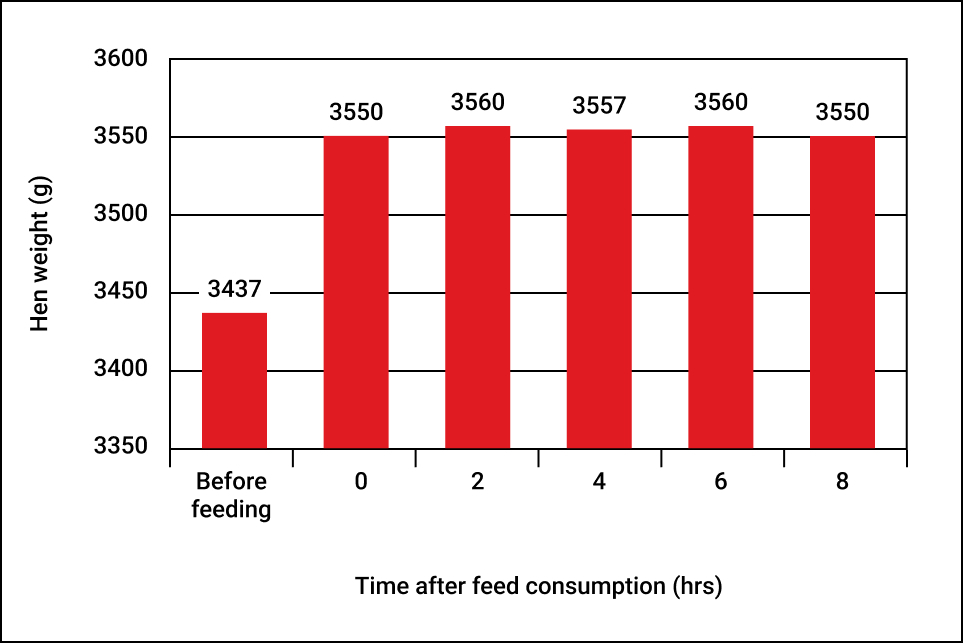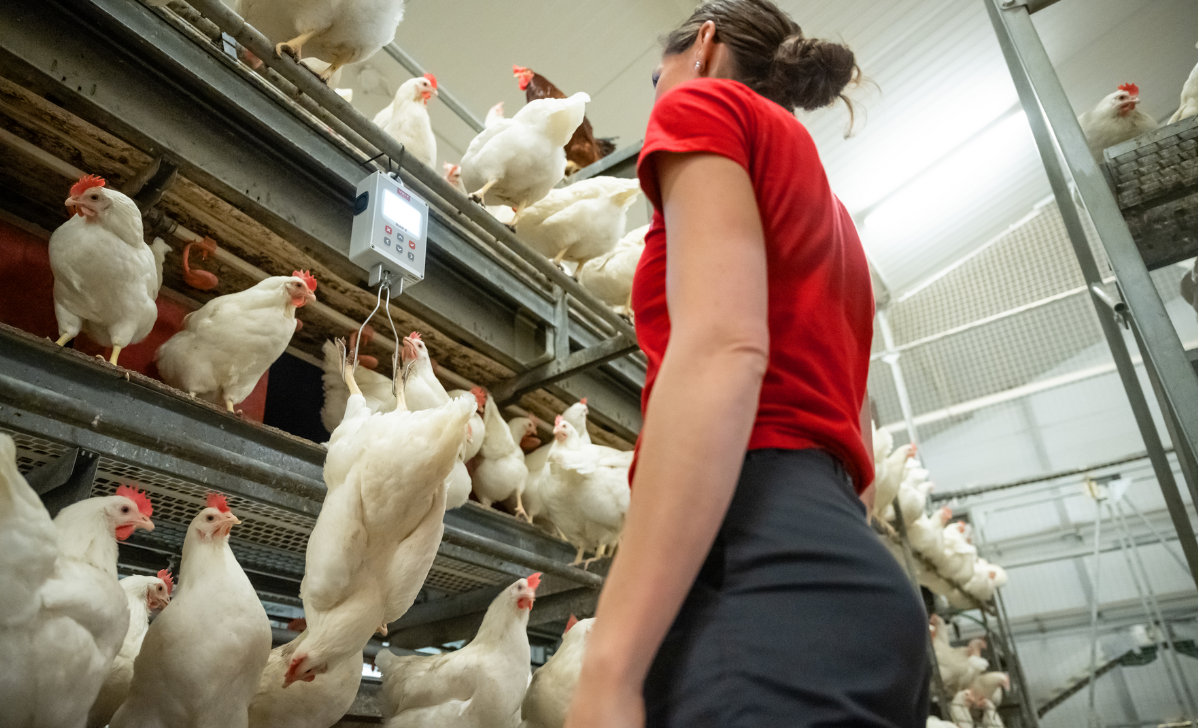Accurate weighing and proper sample selection during the rearing and maintenance of broiler breeder hens are crucial throughout their lifetime. For farmers and technical services, knowledge of body weight and uniformity is essential for making informed decisions that have a long-term impact on productivity.
Determining the feed ration based on incomplete or inaccurate body weight information often leads to overfeeding or, conversely, malnourishment. Weight above or below the recommended standard can easily reduce the overall number of eggs laid by more than 10-15 pieces.
Rearing
To properly weigh broiler breeder hens, it is essential to follow specific procedures. Some farms use electronic platform scales that allow them to obtain numerous values throughout each day of rearing. These systems have been observed to not always reflect the many different individuals because many hens tend to jump onto the scales several times during the day. Therefore, it has been proven effective to move these scales to various locations within the facility to achieve a better sample of weighed hens.
Tracking progress
The current weight of hens is the easiest way to monitor the flock’s development. Breeding companies also focus on achieving good body structure and age-appropriate meatiness, primarily before the onset of light stimulation in the flock. This requires farmers to be able to assess the body composition of each hen individually.
Hens should be weighed every week starting from the seventh day of age and continuing at least until after the peak of egg production. Weighing should be done individually before feeding or, in the case of some alternative feeding programs, on days when no feeding occurs.
Weighing hens in two to three places in the facility provides the most accurate results. It is always important to weigh all hens that have been collected in the catching frame. No hens should be excluded from the sample. Even more precise samples can be obtained by simply opening the catching frame and allowing the hens to enter freely without being driven in.
Detecting issues
If the weights do not correspond to the expected growth, it is necessary to promptly determine the cause as accurately as possible. Possible reasons include poultry diseases, incorrect temperatures, air quality problems, insufficient feeding space, slow feed distribution, improper feed composition, or poor feed quality, and often, even the scales themselves are not accurate.
Keeping flocks on schedule
There are certain periods in a hen’s life that are particularly important. The first such period is around four weeks of age, when the farmer can assess whether the initial rearing phase has proceeded correctly. Weight, along with protein intake (grams of protein per hen), should be compared to the breeding company’s recommendations.
Another crucial period is around 15-16 weeks of age. From this age until light stimulation, consistent and proper growth is essential. A weight gain of 33-35% between the 16th and 20th weeks of age is necessary to achieve the appropriate meatiness and to increase the reserve of body fat in relation to the readiness of hens for extended daylight.
If the weight of hens at 16 weeks is higher than the standard, it is difficult to achieve proper fat deposition without hens later becoming significantly overweight. At this point, attempting to reach the standard by 20 weeks will slow down the development of meatiness, fat deposition, and changes in body composition. Such a hen will not respond to extended daylight with the development of reproductive organs and egg follicles. Instead, it will continue to increase in weight and fat deposition until it is ready to lay, but will not be able to fully benefit from extended exposure to light.
Production
If alternative feeding is used during rearing, where some days are skipped, as in systems like skip-a-day (4 + 3, 5 + 2), in layer houses, it is always necessary to feed every day because growing hens need a consistent supply of nutrients during this period of their lives. Weekly weighing is also necessary here. The results of weighing hens are sometimes discussed in relation to whether or not hens have a certain amount of feed in their digestive tract after consuming the daily ration. It was generally assumed that only pre-feeding weights could be considered accurate to avoid estimating how to adjust the weighing result in relation to the feed that hens consumed. In contrast to this approach, recent research conducted by the University of Arkansas in the USA has shown that hen weights remain essentially constant throughout the day after two hours have passed since the feed was consumed.

As a result, the farmer does not have to wait until the afternoon to weigh, and the results will still be accurate. The weights shown in the table were obtained by weighing all the hens in the box, so there could be no weighing error due to different samples of hens. The hens were fed a daily ration of 139g per hen. The data obtained is typical for hens at any stage of production, consistent and repeatable, even when the laying period begins. Research has shown that hens can be weighed anytime after two hours have passed since the feed was consumed without a change in the accuracy of weighing results. This can help farmers who need to weigh multiple flocks during the day make better use of their entire workday for weighing hens.
Reaching expected output
Hens should be regularly weighed throughout the flock’s lifetime. From the beginning of production, which can be defined for this purpose as 3% laying, until the peak of egg production, hens should achieve a growth of 18-20%.
If this growth is lower, it is necessary to focus on estimating fat reserves and body composition because low growth may indicate that hens are not receiving enough nutrients for production and body growth, which can subsequently affect laying persistence.
On the other hand, too much growth (over 20%) indicates that hens are receiving more nutrients than they actually need, and excessive weight also negatively affects persistence. Weighing hens is a very good method for monitoring the flock’s condition, but some other factors are also important in deciding on the effectiveness of feeding procedures. For example, even if hens are gaining weight correctly, if the time needed to consume the entire daily ration is either too short or too long, it can indicate the direction in which the hens‘ weight will go in the coming weeks. If consumption time is longer than 2.5-3 hours or, conversely, shorter than 0.5 hours, it may mean that the feed rations are not set correctly, and the hens‘ weight may grow too rapidly in the following weeks, or, on the contrary, the weight gain will be too low. However, different consumption rates among different hybrids, feed structure, house temperature, and other factors should be taken into account.
An ongoing effort
Hens should be regularly weighed even after reaching the peak of egg production to ensure proper feed consumption. Weighing is even recommended more frequently than once a week if the situation arises where hens deviate significantly from the given standard.
Although each flock is different, the common practice is to reduce the amount of feed given at the peak of egg production by 12-14% over the course of their remaining lives. This percentage must always be modified according to the weight of hens in production. Hens should continue to achieve small weight gains after the peak of egg production to ensure good persistence. Constant monitoring of weight allows for proper and accurate feed consumption.
